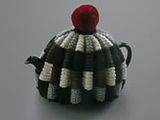Il Divo (Paolo Sorrentino, 2008) (Human Rights Film Festival - otvorenje)
 Slika maznuta odavde www.cinemavistodame.com/tag/paolo-sorrentino/ Puni naslov filma Božanski: Neobičan život Giulia Andreottija, svojom konstrukcijom zaziva srednjevjekovne hagiografije i dokumentiranje svetačkih čuda koja su rezultirala beatifikacijom. No, kako je protagonist filma istovremeno i izuzetno važan talijanski političar iz redova Kršćanske demokratske stranke koji je sedam puta uspio postati premijerom, a kao ministar je pokrivao sva žešća ministarstva (unutrašnjih poslova, obrane i vanjskih poslova), te se provukao gotovo neokrznut kroz 26 različitih sudskih procesa u kojima ga se pokušalo ščepati zbog veza s mafijom, naslov naravno diše dvosmisleno jezovito. Andreotti je, važno je spomenuti, i danas vrlo živ i vrlo aktivan, dok se oko njega godinama talože mrtvaci, neki od njih upravo oni koji su njemu nagovještali ranu smrt. Lista onih koji su kihnuli prije njega, i to, naravno, onim što bi se nazvalo ”neprirodnom” smrću je oveća, al evo samo par slučajeva: Aldo Moro kojeg su otele i ubile Crvene Brigade, Mino Pecorelli, koji je navodno kanio razotkriti Andreottijeve veze s Cosa Nostrom, vješanje ”Božjeg bankara” Roberta Calvija, ubojstvo Salva Lime, Andreottijeve desne ruke na Siciliji. Ne samo da je živ i zdrav, iako se vjerojatno i dalje natače šumećim Andolima protiv glavobolje, Andreotti danas snima reklame za mobitele. Čini se da Giulia doista čuva Bog, a taj Bog je ”onaj koji zna, kao što zna i Giulio, da se ponekad mora činiti zlo da bi se činilo dobro”. Il Divo je izuzetno dobro saštrikan film. Samo što bod nije narativan (jadna li sam s ovim švelja metaforama, nemam pojma ima li ova prispodoba ikakvog smisla, možda da neka pletilja ponudi kritičku analizu), već je prije simboličko-asocijativan. Drugim riječima, film frustrira gomilom detalja o talijanskoj političkoj sceni koji nisu prilagođeni kognitivnom aparatu gledatelja tako da je fiks Wikipedije i rasprsnuće po linkovima na linkove na linkove nužan. (”Ko je sad pa ovaj jadna mu sicilijanska majka?” je vjerojatno rečenica koja mi je najviše puta prošla kroz glavu tijekom gledanja filma). Ipak moram priznati da sam rado istrpila takvu glavobolju, pa i zato jer se radi o filmu koji se ipak prilično vjerno drži stvarnih događaja. (Preciznije, nemam pojma drži li ih se vjerno ili nevjerno, ali izgleda kao da ih se drži vjerno. A što se tiče pridjeva ”stvarnih” u ”stvarni događaji” recimo samo da se to odnosi na ideju da se o tim događajima puno pisalo, ne samo u talijanskoj štampi, i da se do određene narativne potke lako može doći, čak i nakon kraćeg istraživanja. Šta je tu stvarno ”stvarno” ostavila bih Giuliovom Bogu). Oslanjanje filma, dakle, na vanfilmski univerzum, omogućava redatelju da se opušteno pozabavi onime što ga pali: radom kamere, neobičnim kadriranjem, portretiranjem likova, seksi asocijativnim povezivanjima, atmosferom, intenzitetom etc. I tu je zaista Sorrentino (zajedno s ekipom, osobito Tonijem Servillom koji glumi Andreottija) obavio majstorski posao. Božanski Giulio (Il Divo je nadimak koji dijeli s Julijem Cezarom) zvan još i Belzebub, Crni papa, Lisica, Grbavac i Princ tame je lik koji izaziva dugine boje osjećaja: od apsolutne jeze zbog njegovog ukočenog tijela i mimike hodajućeg mrtvaca, preko frustracije nad činjenicom da je takav lik izjeguljio sve te silne sudske procese (od kojih je jedan jednostavno otišao u zastaru, iako bi na njemu pao), nježnosti i skoro pa potrebe da ga se zaštiti (o, prokleti majčinski instinkti i jebena ženska biologija, koštate me daleko preskupo za ono što nudite, žudim da imam tijelo muškarca) izazvane tim ogromnim naočalama, ušima koje na svojim vršcima stoje gotovo okomito u odnosu na glavu, skrušenim, skoro pa skromnim držanjem, stalnim iscrpljujućim glavoboljama, pa zatim time da ga je Morova smrt očito ipak duboko pogodila jer se, kako tvrdi u filmu, sve do te smrti od njega odbijalo, odnosno s njega skliznulo bez da ga ozbiljnije zakači. Sorrentinov Andreotti izaziva još i… ne bih rekla divljenje, već nekakvu začudnost kontingencijom svijeta: Kako zaboga ti? Zašto baš ti? Kako se događaji tako fino slažu da se ti uvijek izvučeš? i, s druge strane, savršenom upornošću Andreottijeve volje. On želi, preciznije, “he wills“, on može potegnuti. (Ne radi se o želji, jer se u osnovi čini da Andreotti i nema želja (as in ”desire”), već da ga neka ”slijepa volja” gura naprijed.) To se manifestira kao jedini kriterij Andreottijevog ”uspjeha” ili uvođenja reda u jezovito kaotični svijet koji film nudi. Ta volja, u kombinaciji s grotesknom komikom koja mjestimice ekscesno eksplodira (kao u totalno Lynchovskoj sceni političkog partija koja posebno podsjeća na ending credits iz Inland Empire) čini film prilično ”kazališnim”, u onom klasičnom smislu kazališta kao tragedije. Čini mi se zato da barba Pere (Petar Milat, selektor festivala) koliko god tvrdio da su film i opera ultimativne umjetničke vrste, ono što on u njima vidi kao zanimljivo jest zapravo izvorno kazališno. Isto tako je, nažalost, izvjesno da se to specifično “kazališno” danas rijetko susreće u teatru. Što se tiče socijalnih aktivnosti oko festivala, tipa poslijefilmskog partija, moram skrušeno priznati da sam popila samo jednu travaricu i jednu morlačku rakiju, i to još prije projekcije, a da sam se nakon nje brzinski sastavila s krevetom. Dakle, ne znam ko je koga jebo jučer navečer (što je neobično, jer inače uglavnom znam). Možda da me upoznate s tim u komentarima? |



